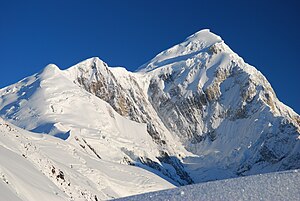Spantik
| Spantik | ||
|---|---|---|
|
The southeast ridge (left) is the normal route |
||
| height | 7027 m | |
| location | Gilgit-Baltistan ( Pakistan ) | |
| Mountains | Spantik Sosbun Mountains ( Karakoram ) | |
| Dominance | 10.2 km → Malubiting | |
| Notch height | 1187 m ↓ Polan La ( 5840 m ) | |
| Coordinates | 36 ° 3 '26 " N , 74 ° 57' 29" E | |
|
|
||
| First ascent | July 6, 1955 by Reiner Diepen , Eduard Reinhardt and Jochen Tietze | |
| Normal way | Southeast ridge | |
|
The northwest side of the Spantik with the Golden Pillar on the light-shadow border |
||
Spantik ( Urdu سپانٹک, also Golden Peak ) is a 7027 m high mountain in the Karakoram in northern Pakistan . It is the highest and at the same time westernmost mountain of the Spantik-Sosbun Mountains .
location
In the south, the Spantik on Polan La , a 5840 m high saddle, is connected to the Malubiting (in the Rakaposhi Haramosh Mountains ). Between the two mountains lies the nutrient area of the Chogolungma Glacier , which flows eastwards from there and separates the Spantik-Sosbun Mountains in the north from the eastern Rakaposhi-Haramosh Mountains in the south. Both mountain ranges belong to the "Little Karakoram". To the north of the Spantik, beyond the Hispar Glacier, lie the Hispar Muztagh mountains , which are part of the Karakoram main chain ("Great Karakoram").
Surname
Although the Spantik is closer to the Hunza Valley , its official name comes from the Balti language. It is made up of Spang ("grass") and Tik ("place") and initially referred to a green slope on the southeast ridge of the mountain, later the name was used for the whole mountain. In Burushaski , the language of the Hunzukuc , the name is Ghenish Chhish - Golden Peak ("Golden Peak").
Ascent history
As early as 1906, the Americans Fanny Bullock Workman and her husband William Hunter Workman tried to climb the mountain they called Pyramid Peak , but they lacked 300 meters in altitude to reach the summit. It was not until 1955 that the Germans Reiner Diepen, Eduard Reinhardt and Jochen Tietze managed to climb from the Chogolungma glacier on the southeast side. In 1987 a small English expedition traveled to the north face of the Spantik to climb the 2200 m high Golden Pillar ("Golden Pillar"). Antony Victor Saunders and Michael Fowler reached the summit after a six-day climb in alpine style . This first ascent was only the fifth ascent of the mountain. Meanwhile, the mountain is considered to be one of the easiest seven-thousand-meter peaks on the normal route, and its ascent is offered by commercial expeditions.
Web links
- Spantik on Peakbagger.com (English)
Individual evidence
- ^ A b Anthony Victor Saunders: "Spantik: The Golden Pillar. In: American Alpine Journal 1988, pp. 21-28 (AAJO) (PDF; 1.4 MB), accessed August 10, 2011.
- ^ Asia, Pakistan, Chogo-Lungma Region . American Alpine Journal, 1956, vol. 10.
- ↑ Information about the Spantik on the website of a commercial expedition provider ( memento of the original from November 3, 2011 in the Internet Archive ) Info: The archive link was automatically inserted and not yet checked. Please check the original and archive link according to the instructions and then remove this notice. , Accessed August 10, 2011.


